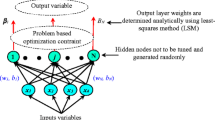Abstract
The accurate and reliable measurement of effluent quality indices is essential for the implementation of successful control and optimization of wastewater treatment plants. In order to enhance the estimate performance in terms of accuracy and reliability, we present a partial least-squares-based extreme learning machine (called PLS-ELM) in this paper. The partial least squares (PLS) regression is applied to the ELM framework to improve the algebraic property of the hidden output matrix, which can be ill-conditional due to the high multicollinearity of the hidden layer output. The main idea behind our proposed PLS-ELM is to achieve a robust generalization performance by extracting a reduced number of latent variables from the hidden layer and using orthogonal projection operations. The results from a case study of a municipal wastewater treatment plant show that the PLS-ELM can effectively capture the input–output relationship with favorable performance against the conventional ELM.








Similar content being viewed by others
References
Olsson G (2006) Instrumentation, control and automation in the water industry state-of-the-art and new challenges. Water Sci Technol 53(4–5):1–16
Zhu JB, Zurcher J, Rao M, Meng M (1998) An online wastewater quality predication system based on a time-delay neural network. Eng Appl Artif Intel 11(5):747–758
Lee DS, Jeon CO, Park JM, Chang KS (2002) Hybrid neural network modeling of a full-scale industrial wastewater treatment process. Biotechnol Bioeng 78(6):670–682
Zhao LJ, Chai TY (2005) Wastewater BOD forecasting model for optimal operation using robust time-delay neural network. Lect Notes Comput Sc 3498:1028–1033
Sharmin R, Sundararaj U, Shah S, Griend LV, Sun YJ (2006) Inferential sensors for estimation of polymer quality parameters: Industrial application of a PLS-based soft sensor for a LDPE plant. Chem Eng Sci 61(19):6372–6384
Tomida S, Hanai T, Honda H, Kobayashi T (2001) Construction of COD simulation model for activated sludge process by recursive fuzzy neural network. J. Chem Eng Jpn 34(3):369–375
Vapnik V (1995) The nature of statistical learning theory. Springer, New York
Huang GB, Zhu QY, Siew CK (2006) Extreme learning machine: theory and applications. Neurocomputing 70(1–3):489–501
Huang GB, Wang DH, Lan Y (2011) Extreme learning machines: a survey. Int J Mach Learn Cyber 2(2):107–122
Qin SJ (1998) Recursive PLS algorithms for adaptive data modeling. Comput Chem Eng 22(4–5):503–514
Helland IS (2001) Some theoretical aspects of partial least squares regression. Chemometr Intell Lab 58(2):97–107
Wold S, Trygg J, Berglund A, Antti H (2001) Some recent developments in PLS modeling. Chemometr Intell Lab 58(2):131–150
Huang GB, Chen L, Siew CK (2006) Universal approximation using incremental constructive feedforward networks with random hidden nodes. IEEE Trans Neural Netw 17(4):879–892
Wold S, Sjöström M, Eriksson L (2001) PLS-regression: a basic tool of chemometrics. Chemometr Intell Lab 58(2):109–130
Geladi P, Kowalski B (1986) Partial least squares regression: a tutorial. Anal Chim Acta 185:1–17
Baffi G, Martin EB, Morris AJ (1999) Non-linear projection to latent structures revisited: the quadratic PLS algorithm. Comput Chem Eng 23(3):395–411
Acknowledgments
The work is supported by NSF in China (61020106003 and 60874057), China’s Postdoctoral Science Foundation (20100471464), and also by a matching grant for 1000 talent program (P201100020).
Author information
Authors and Affiliations
Corresponding author
Rights and permissions
About this article
Cite this article
Zhao, L., Wang, D. & Chai, T. Estimation of effluent quality using PLS-based extreme learning machines. Neural Comput & Applic 22, 509–519 (2013). https://doi.org/10.1007/s00521-012-0837-1
Received:
Accepted:
Published:
Issue Date:
DOI: https://doi.org/10.1007/s00521-012-0837-1




